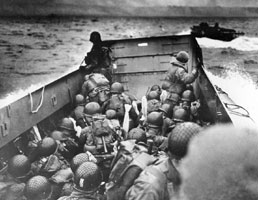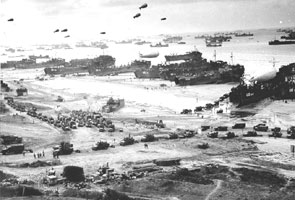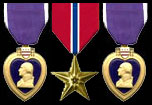 |
North
High School Wall of Honor
Jess J. Richardson
Left during Class of 1939
Would have graduated in June, 1940
|
 |
 |
|
Research done by Claradell Shedd, class of 1953. |
| Jess J. Richardson |
 |

|
Jess left North High in 1939, but he would have graduated
from North High in June, 1940. He enlisted in the Iowa National
Guard at Camp Dodge in 1940. He retired on October 27, 1945
as a Master Sergeant.
|
 |
| Jess
J. Richardson; MSgt. |
|
|
| Jess J. Richardson |
 |
| Year |
|
Rank |
|
Status |
 |
| Enlisted |
|
 |
|
Location, date when
he enlisted. Iowa Army National Guard; Camp Dodge, IA. |
| June, 1940 |
|
x |
|
Would have graduated from North
High, Des Moines, IA |
| 1-1/2
yrs. |
|
|
|
Camp Brownwood,
TX. Then Ft. Hood, TX. |
| June, 1944 |
x |
US Army |
x |
8th Army Corps; 6 days after
Normandy (June 6, 1944). To Omaha Beach. 113th Cavalry Group,
125th Cavalry Reconnaissance Squadron; The Red Horse Cavalry
Group. |
| date |
x |
|
x |
Holland, Belgium, Germany,
France |
| October 27, 1945 |
x |
Rank/MSgt. |
x |
Discharged; Camp Atterbury,
IN |
| 1946-81 |
x |
Civilian |
x |
Rock Island Railroad for 35
years. Retired in 1981. |
| August 4, 2008 |
x |
Deceased |
x |
Buried at American
Veterans Cemetery, Van Meter, IA. |
|
 |
 |
| Normandy |
Omaha Beach |
|
|
113th Cavalry Reconnaissance
Squadron (Red Horse Cavalry)
Personal history of Cpl James Hall, by his
grandson: http://www.battlevault.com/Events/Wolfkrieg-08%20Flames%20of%20War/Player%20List-Hist/Scott%20Hall-Hist.pdf |
113th Cavalry Reconnaissance Squadron
A brief history of the 113th Cavalry Reconnaissance
Squadron, 113th Cavalry Group Mechanized, XIX
Corp, 1st Army.
Intro
Why play the 113th Cavalry Reconnaissance? It's
surely not because it's an easy force to play, and it's
definitely not its overwhelming firepower. My reason for modeling
and playing the 113th is simply
because it was the unit in which Cpl. James Hall, my grandfather,
served. He was a member of Troop
E, the assault gun troop. He joined the Troop on the 28th of September
1944; crossed the Roer, Rhine,
Weser, and Elbe with them; fought on the northern shoulder of
the 'Bulge' with them; received a purple
heart for being wounded in action in Stirzilburg, Germany; and
was with the first group to meet up with
the Soviets before entering Berlin.
Origins
The 113th Cavalry Regiment originated as an Iowa
National Guard unit with history tracing back to the
19th century Indian Wars. Its distinctive coat of arms featuring
a Red Horse rampant, a prickly pear
cactus (for its service along the Mexican border), and a fleur
de lis (for its service during the WWI), has given the unit the
nickname of the "Red Horse Cavalry".
Reorganization
With its mechanization in 1944, the 113th Cavalry
was reorganized into three groups, 113th Cavalry
Headquarters, 113th Cavalry Reconnaissance Squadron, and the 125th
Cavalry Reconnaissance
Squadron. Collectively known as the 113th Cavalry Group Mechanized,
they were commanded by Col.
William S. Biddle of Portland Oregon, and a West Point graduate,
class of 1923. The 113th Cavalry
Reconnaissance Squadron was commanded by Lt. Col. Allen D. Hulse,
and the 125th by Lt. Col.
Anthony F. Kleitz.
Organization
The mechanized cavalry squadrons were organized
with three Cavalry Troops, lettered A to C, each
equipped with 13 M8 Greyhound armored cars and jeeps, an Assault
Gun Troop, E, with six M8 Scott
HMC; a Light Tank Company, F, with 17 M5 Stuarts, later replaced
with M24 Chaffee tanks; a Service
Company; and an H&H Company.
Role
Cavalry Squadrons were primarily intended for reconnaissance
missions. However, during the war
they were usually employed in defensive, security, or screening
missions. Armored field artillery,
engineer, and tank destroyer units reinforced the cavalry for
most missions.
The cavalry groups were seldom called to perform their primary
duty, and later analysis showed
that pure reconnaissance missions accounted for only 3 percent
of their activities. The lion's share of
missions included defensive operations; special operations (such
as security, road blocks, rear
screening); security missions (such as flank protections, and
filling gaps), and purely offensive
operations.
Highlights of service during the war
The 113th saw its first engagement with the Germans
in Normandy. The Cavalry put aside its
reconnaissance tactics and took on the 17th SS Panzer Grenadier
Division head on, when the Group
crossed the Vire et Taute Canal on July 7th and took the towns
of Goucherie and Le Mesnil-Veneron. It
fought amongst hedgerows against what turned out to be a German
counterattack aimed at Carentan and Isigny for four days.
With the fall of Gathemo, the 113th got a chance to stretch its
legs and really move across the
countryside. On August 13th, the group marched 32 miles to Mortain,
paused, and then set up a moving screen in front of the 30th ID
to Dornfront. Here the 125th Cavalry Reconnaissance Squadron worked
with the 82nd Armored Reconnaissance Btn in the capture of the
heavily defended 17th century fortress, while the 113th covered
a sizeable gap between two advancing infantry regiments, an action
which earned them a commendation from Division Commander, Maj.
Gen. Leland S. Hobbs.
On September 5th, the Group under the XIX Corp, and with Company
B of the 82nd Engineer Combat
Battalion and Company C of the 803rd Tank Destroyer Battalion
attached, moved on what is believed to
have been one of the most spectacular mechanized cavalry reconnaissance
missions in military history,
when it made its brilliant dash across Belgium three days in advance
of the Corps. Light, and even
moderate resistance was fought, or brushed aside, and heavy resistance,
of which there was considerable, was reported and by-passed. All
types of enemy fron Panther tanks to infantry were encountered.
Messenger service was maintained by plane and communications by
long-distance radio.
During the 'Bulge', the group was primarily responsible for flank
protection in the Maastricht-Aachen-
Ligen area. The group remained on its defensive mission in the
Geilenkichen area until shortly after
Christmas, when they moved to the area of Gey, on the northern
edge of the Hurtgen forest. While
defending this particular sector, the group patrolled aggressively,
and during the night of January 19-
20, Troop 'C', 113th Cavalry Reconnaissance Squadron conducted
a raid across the Roer, returning with
six prisoners, the first prisoners taken on the Corps front in
three weeks.
The 113th were the first units across the Roer, the Elbe, the
Rhine, the Ruhr, and the Weser. Always at
the front of the advance, the 113th were always given priority
to fuel, sometimes to the detriment of the
advance of the 2nd Armored.
On April 9th, the group accepted the surrender of the city of
Einbeck which had been captured by Troop 'B' of the 113th Cavalry
Reconnaissance.
During the 312 days of combat and over a distance of some 800
miles from the Normandy Bridgehead
to east of the Elbe, the group captured approximately 600 enemy
tanks, armored cars, half-tracks and
vehicles, and captured 21,599 prisoners. |
|



|
Jess
J. Richardson
113th Cavalry (Red Horse) Group
125th Cavalry Reconnaissnce Sqdrn.
Master Sergeant
)

Red
Horse website

Purple Heart, Bronze Star, Purple Heart |
|
|
|
| Died:
08/04/08. Buried at American Veterans Cemetery, Van Meter, IA. |
| Music:
"You Raise Me Up" |
Home
|
Back/allyears |
WWI |
WWII |
Korea |
Vietnam |
Afghanistan/Iraq |
Lyrics
|
Refs/Awards |
Contact
©2025-csheddgraphics All rights reserved.
All images and content are © copyright of their respective copyright
owners. |
|









